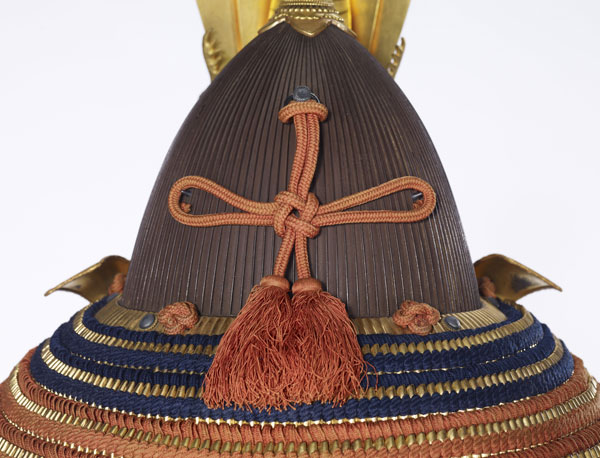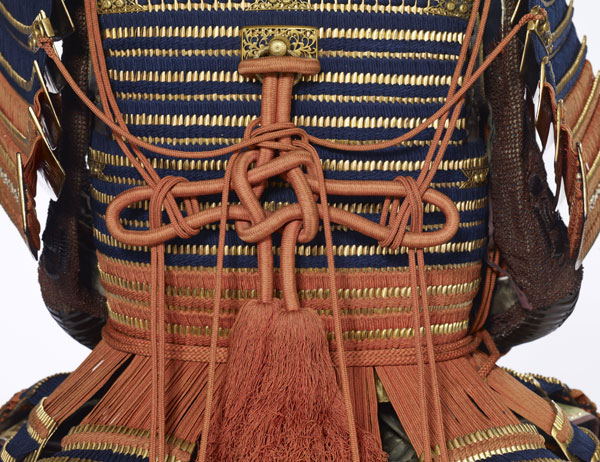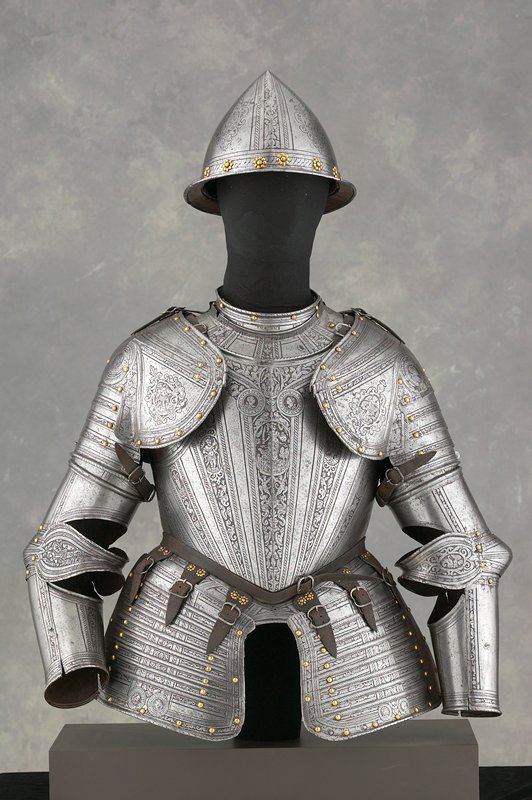Japanese Samurai Armor

Armor, 17th century
iron, leather, lacquer, silk, wood, gold leaf and powder, bear fur
The Ethel Morrison Van Derlip Trust Fund
Introduction
Precious materials, fine details, and exceptional craftsmanship—all are hallmarks of the beauty and artistry in Japanese culture. Yet, some artworks are more than purely decorative. A clever design made this lightweight suit of armor highly protective when worn by a Japanese samurai warrior in hand-to-hand combat.
KEY IDEA ONE
Serving in Style
From the 14th to the 19th centuries, Japan was ruled by a feudal government system. Regional families known as daimyo (“dime-yo”) controlled vast territories of land and workers. Frequently at war with one another, daimyo employed highly skilled warriors, known as samurai, to protect their riches.
Samurai get their name from the Japanese word “saburau,” meaning “to serve.” These warriors were famous for their bravery, loyalty, and commitment to duty. They were also known for their distinctive armor. This suit of armor includes a helmet topped with a praying mantis. Known for its fearlessness, this insect would have symbolized the wearer’s bravery on the battlefield and embodied his threat to the enemy.
Over the centuries, samurai gained elevated status within feudal Japan’s tiered society. Most were wealthy and educated, and their interests in and patronage of art forms such as architecture, calligraphy, poetry, and the unique Japanese tea ceremony helped to develop, enhance, and define Japan’s artistic culture. Objects like this suit of armor emphasize the importance of beauty and artistry of even the most functional objects, values that continue to be important in Japanese society today.

Samurai were highly regarded in Japanese culture for their loyalty and dedication as well as for their prominent social status.
Kobayashi Kiyochika, _Warrior Departing for a Battle_, 1880–99, color woodblock print, Minneapolis Institute of Art, Bequest of Louis W. Hill, Jr.
KEY IDEA TWO
A Sumptuous Suit
In 1600, the Tokugawa family took control of Japan. Their rule brought 250 years of peace and stability to the country, an era known today as the Tokugawa or Edo period. This suit of armor was made early in this reign in the Kii Province, which was headed by Tokugawa Yorinobu (1602–71), the tenth son of the dynasty’s founder. Although the identity of the armor’s original owner is uncertain, it is possible that the suit was made for Yorinobu himself; a hollyhock, the crest of the Tokugawa family, can be found in multiple locations on the armor.
Even during the peaceful Edo period, military skillfulness was practiced and protective armor was produced. However, greater attention was placed on appearance, as craftsmen combined the most striking features of older styles into stunning new suits of armor.
From top to bottom this suit of armor features outstanding embellishments that indicate the status of its owner. An impressive number of crimped metal layers make up the helmet, or “kabuto,” which is topped by a delicately carved and gilded praying mantis. Gold is also lacquered onto the hundreds of metal plates, or “sane,” which form the suit’s protective coverings. Delicately painted scenes on protective leather back-and-chest plates illustrate animals traditionally associated with luck and longevity. Some of the expensively dyed silk cords fasten the sane together, while elegantly knotted others hold the protective layers in place.

The presence of the hollyhock, the crest or coat of arms of the Tokugawa family, may indicate the importance of its owner.

This acorn-shaped helmet was made with an impressive 124 plates of metal.

Red dye, made from safflower, was an expensive luxury and emphasizes the status of the armor’s owner.
KEY IDEA THREE
Fully Functional
Though this stunningly decorated suit of armor was unlikely to have been worn in battle based on its near-perfect condition, it was made to be practical and battle-ready. Its components are fitted, lightweight, and very flexible, allowing for freedom of movement as a samurai fought with his sword. Even the helmet’s fanciful praying mantis would have torn away easily in battle so as not to entangle the warrior with his enemy.
A distinguishing feature of Japanese armor are the hundreds of tiny iron and leather “sane” plates stacked together and covered in lacquer and gold leaf, then laced together with silk cords. Sane panels flexed and moved with the warrior, protecting him from the sword of his enemy. The skirt, or “kusazuri,” was also made up of sane to protect the lower body. It is divided into eight sections to allow the wearer ease of mobility. Fancifully knotted silk cords are not only beautiful, but they also function to keep the plated shoulder guards in place while enhancing freedom of movement. Further shielding its wearer, this suit of armor includes additional features such as a facemask, helmet, throat protector, hand and arm guards, leg guards, and boots.

Unlike rigid Western armor, this Japanese suit is light and flexible and allowed the wearer a greater range of motion in battle.
Italy, Half Armor, c. 1570–80, steel, leather, cloth, Minneapolis Institute of Art, Gift of Wayne and Rosalee MacFarlane.

Hundreds of metal plates, lacquered and gilded, are laced together with red and blue silk cords to produce a flexible shield capable of protecting the warrior from an enemy’s sword.

Hand and arm guards add to the full-body protection of the samurai.
Related Activities
Bravery on the Battlefield
Today, the United States military fights for the freedom of people all over the world. Send a soldier a letter of thanks for their service to our country, or start a collection of care packages to ship to service people working in faraway places.
Worldly Warriors
Use the search function on Mia’s websiteto search for other artworks related to warriors, arms, and armor from around the world. Even better, plan a trip to Mia to see arms and armor up close and personal. Compare what you see. What does the European armor have in common with the Japanese suit of armor? What differences do you notice? Which seem to be the most comfortable, flexible, and functional? What do you see that makes you say that?
See for Yourself
Plan a trip to Mia to see arms and armor up close and personal. View Japanese samurai art on the second floor. Then travel to see European armor on extended loan from the Metropolitan Museum of Art on the third floor in the Medieval Art Galleries. Compare what you see. What does the European armor have in common with the Japanese suit of armor? What differences do you notice? Which seem to be the most comfortable, flexible, and functional? What do you see that makes you say that?
